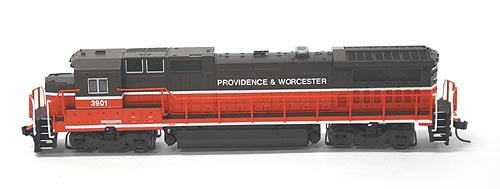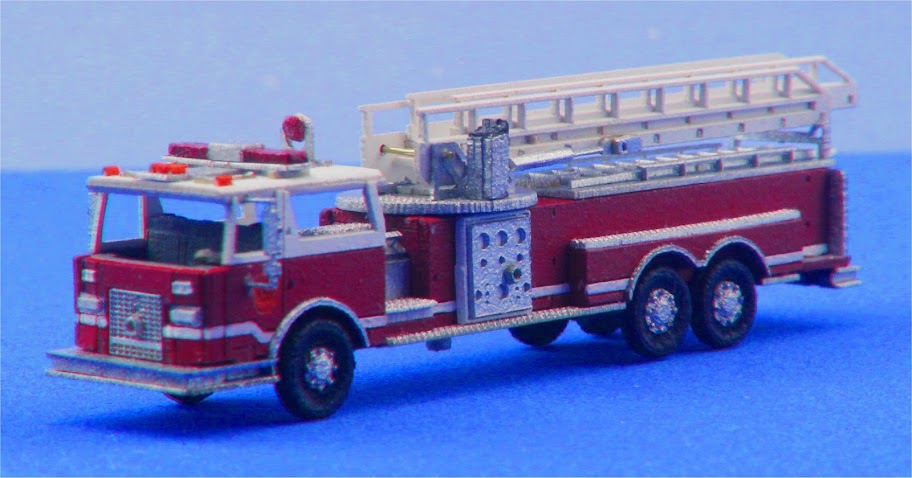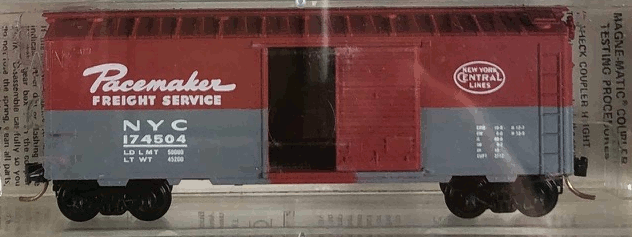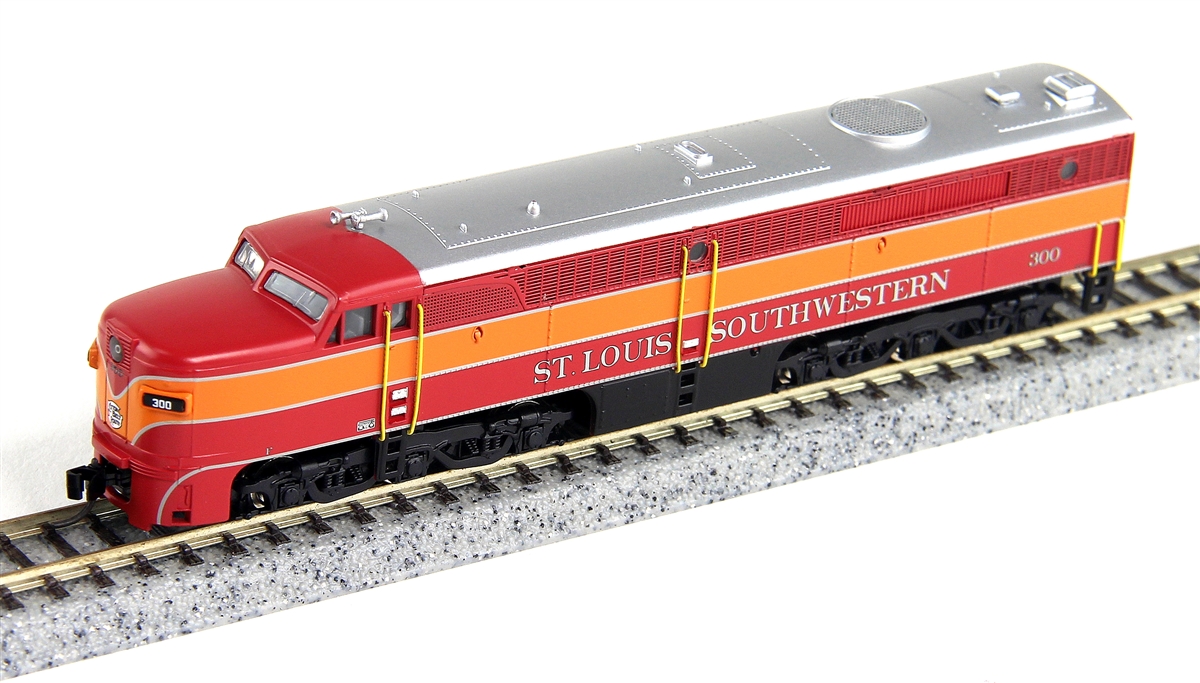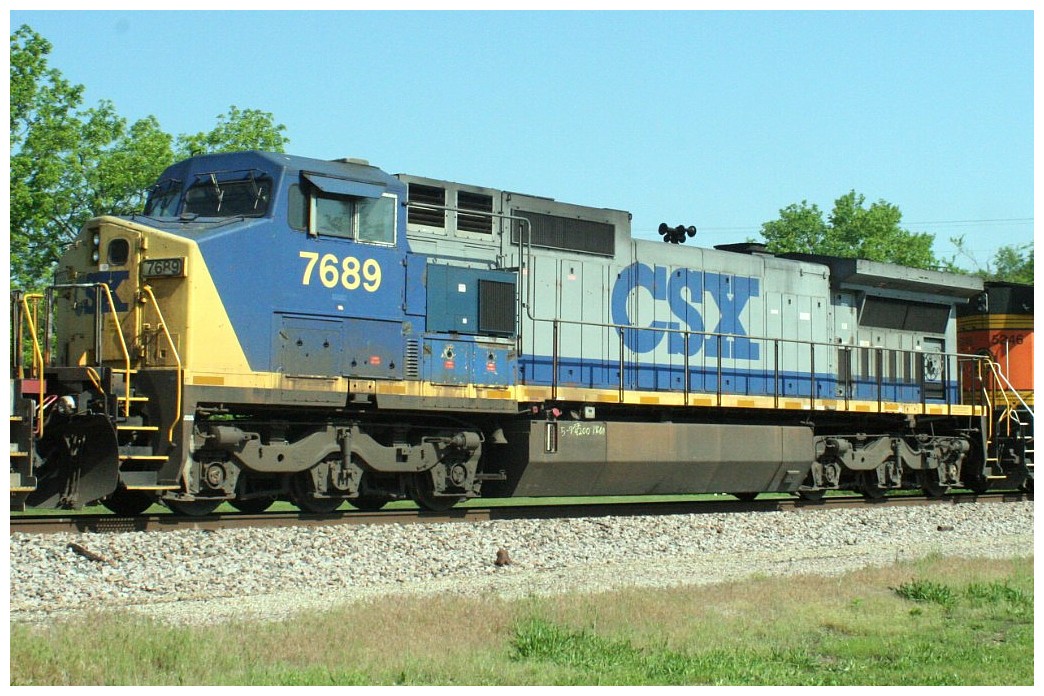Model Information: The Dash-8-32, Dash-8-40B, Dash-8-40BW, Dash-8-40C and Dash-8-40CW all share the same mechanism and only differ in the shell details. This series of models was introduced in 2002.
These models are excellent runners and feature the standard attributes of a modern Atlas Diesel: blackened metal low-profile wheels, a split frame, dual flywheels, accumate couplers, and LED lighting. I have run over 40 cars on a single Dash-8. I have a CSX model in my personal collection and frequently run it with long consists at NTRAK meets.
These models are excellent runners and feature the standard attributes of a modern Atlas Diesel: blackened metal low-profile wheels, a split frame, dual flywheels, accumate couplers, and LED lighting. I have run over 40 cars on a single Dash-8. I have a CSX model in my personal collection and frequently run it with long consists at NTRAK meets.
Prototype History: The Dash 8 Series is a line of diesel-electric freight locomotives built by GE Transportation Systems. It replaced the Dash 7 Series in the mid-1980s, and was superseded by the Dash 9 Series in the mid-1990s. All models of the Dash 8 Series are powered by a 16- or 12-cylinder, turbocharged, GE 7FDL 4-stroke diesel engine.
The design of the Dash 8 Series is based upon that of the Dash 7 Series. The biggest changes introduced during the production of the Dash 8 Series were the first use of a microprocessor-equipped engine control unit in a diesel locomotive, and the adoption of a modular system in the construction of the vehicle body. The Dash 8 locomotive bodies were assembled from several modules, creating a combination to fit the length of the chassis. On models with a traditional narrow short hood, the part of the equipment room immediately behind the cab is taller than the top of the rounded cab roof, giving those models a distinctive appearance. On all models, that part of the equipment room houses the cooling fans for the dynamic braking system. Traction motors of Dash 8 locomotives were powered by direct current.
The "W" suffix used for some models indicates the then-optional wide-nose "North American" safety cab.
The GE Dash 8-32BHW (or Dash 8-32BWH) is a variant built with Head End Power (HEP) and a wide cab for Amtrak service.
From Wikipedia
More on Dash 8-32B on American-Rails.com
The design of the Dash 8 Series is based upon that of the Dash 7 Series. The biggest changes introduced during the production of the Dash 8 Series were the first use of a microprocessor-equipped engine control unit in a diesel locomotive, and the adoption of a modular system in the construction of the vehicle body. The Dash 8 locomotive bodies were assembled from several modules, creating a combination to fit the length of the chassis. On models with a traditional narrow short hood, the part of the equipment room immediately behind the cab is taller than the top of the rounded cab roof, giving those models a distinctive appearance. On all models, that part of the equipment room houses the cooling fans for the dynamic braking system. Traction motors of Dash 8 locomotives were powered by direct current.
The "W" suffix used for some models indicates the then-optional wide-nose "North American" safety cab.
The GE Dash 8-32BHW (or Dash 8-32BWH) is a variant built with Head End Power (HEP) and a wide cab for Amtrak service.
From Wikipedia
More on Dash 8-32B on American-Rails.com
Road Name History:  The Providence and Worcester Railroad (reporting mark PW) (NASDAQ: PWX) is a Class II railroad in the United States. The railroad connects from Gardner in central Massachusetts, south through its namesake cities of Worcester and Providence, Rhode Island, and west from Rhode Island through Connecticut and into New York City. The railroad's connection between New Haven, Connecticut and New York City and onto Long Island is via trackage rights over the Hell Gate Bridge.
The Providence and Worcester Railroad (reporting mark PW) (NASDAQ: PWX) is a Class II railroad in the United States. The railroad connects from Gardner in central Massachusetts, south through its namesake cities of Worcester and Providence, Rhode Island, and west from Rhode Island through Connecticut and into New York City. The railroad's connection between New Haven, Connecticut and New York City and onto Long Island is via trackage rights over the Hell Gate Bridge.
The P&W was incorporated in Massachusetts as the Providence and Worcester Railway on March 12, 1844, and as the Providence and Worcester Railroad in Rhode Island in May 1844. The two companies were merged November 25, 1845 as the Providence and Worcester Railroad. The company bought the Blackstone Canal, also running between Providence and Worcester, and began construction, partly on its banks, in 1845. The line opened in two sections, the part south of Millville on September 27, 1847, and the rest on October 20. The line from Providence to Central Falls was shared with the Boston and Providence Railroad, which at the same time built a connection from its old line (ending in East Providence) over to the P&W.
On July 1, 1892, the New York, New Haven and Hartford Railroad leased the P&W for 99 years. The New Haven merged into Penn Central on January 1, 1969. On April 6, 1970, the P&W announced its intention to separate from the merger. After a legal battle, the Interstate Commerce Commission approved the request on August 25, 1972, and, on November 2, Penn Central signed the agreement, effective December 30. The P&W cancelled the lease on February 3, 1973. Since then, the P&W has taken over many other lines from the former Penn Central in addition to several from the Boston and Maine Railroad. On March 17, 2013, a freight derailed in New Haven, Connecticut, blocking Amtrak's Northeast Corridor.

The P&W was incorporated in Massachusetts as the Providence and Worcester Railway on March 12, 1844, and as the Providence and Worcester Railroad in Rhode Island in May 1844. The two companies were merged November 25, 1845 as the Providence and Worcester Railroad. The company bought the Blackstone Canal, also running between Providence and Worcester, and began construction, partly on its banks, in 1845. The line opened in two sections, the part south of Millville on September 27, 1847, and the rest on October 20. The line from Providence to Central Falls was shared with the Boston and Providence Railroad, which at the same time built a connection from its old line (ending in East Providence) over to the P&W.
On July 1, 1892, the New York, New Haven and Hartford Railroad leased the P&W for 99 years. The New Haven merged into Penn Central on January 1, 1969. On April 6, 1970, the P&W announced its intention to separate from the merger. After a legal battle, the Interstate Commerce Commission approved the request on August 25, 1972, and, on November 2, Penn Central signed the agreement, effective December 30. The P&W cancelled the lease on February 3, 1973. Since then, the P&W has taken over many other lines from the former Penn Central in addition to several from the Boston and Maine Railroad. On March 17, 2013, a freight derailed in New Haven, Connecticut, blocking Amtrak's Northeast Corridor.
Brand/Importer Information: In 1924 Stephan Schaffan, Sr. founded the Atlas Tool Company in Newark, New Jersey. In 1933 his son, Stephan Schaffan, Jr., came to work for his father at the age of sixteen. Steve Jr. built model airplanes as a hobby and frequented a local hobby shop. Being an enterprising young man, he would often ask the owner if there was anything he could do to earn some extra spending money. Tired of listening to his requests, the hobby-store owner threw some model railroad track parts his way and said, "Here, see if you can improve on this".
In those days, railroad modelers had to assemble and build everything from scratch. Steve Jr. created a "switch kit" which sold so well, that the entire family worked on them in the basement at night, while doing business as usual in the machine shop during the day.
Subsequently, Steve Jr. engineered the stapling of rail to fiber track, along with inventing the first practical rail joiner and pre-assembled turnouts and flexible track. All of these products, and more, helped to popularize model railroading and assisted in the creation of a mass-market hobby. The budding entrepreneur quickly outgrew the limitations of a basement and small garage operation. Realizing they could actually make a living selling track and related products, Steve and his father had the first factory built in Hillside, New Jersey at 413 Florence Avenue in 1947. On September 30, 1949, the Atlas Tool Company was officially incorporated as a New Jersey company.
In 1985, Steve was honored posthumously for his inventions by the Model Railroad Industry Association and was inducted into the Model Railroad Industry Hall of Fame in Baltimore, Maryland. In addition, Steve was nominated and entered into the National Model Railroad Association Pioneers of Model Railroading in 1995.
In the early 1990s, the Atlas Tool Company changed its name to Atlas Model Railroad Company, Inc.
In those days, railroad modelers had to assemble and build everything from scratch. Steve Jr. created a "switch kit" which sold so well, that the entire family worked on them in the basement at night, while doing business as usual in the machine shop during the day.
Subsequently, Steve Jr. engineered the stapling of rail to fiber track, along with inventing the first practical rail joiner and pre-assembled turnouts and flexible track. All of these products, and more, helped to popularize model railroading and assisted in the creation of a mass-market hobby. The budding entrepreneur quickly outgrew the limitations of a basement and small garage operation. Realizing they could actually make a living selling track and related products, Steve and his father had the first factory built in Hillside, New Jersey at 413 Florence Avenue in 1947. On September 30, 1949, the Atlas Tool Company was officially incorporated as a New Jersey company.
In 1985, Steve was honored posthumously for his inventions by the Model Railroad Industry Association and was inducted into the Model Railroad Industry Hall of Fame in Baltimore, Maryland. In addition, Steve was nominated and entered into the National Model Railroad Association Pioneers of Model Railroading in 1995.
In the early 1990s, the Atlas Tool Company changed its name to Atlas Model Railroad Company, Inc.
Item created by: trainnut3500 on 2017-06-14 14:21:03. Last edited by Alain LM on 2020-12-03 07:56:15
If you see errors or missing data in this entry, please feel free to log in and edit it. Anyone with a Gmail account can log in instantly.
If you see errors or missing data in this entry, please feel free to log in and edit it. Anyone with a Gmail account can log in instantly.


